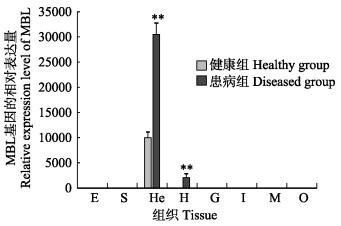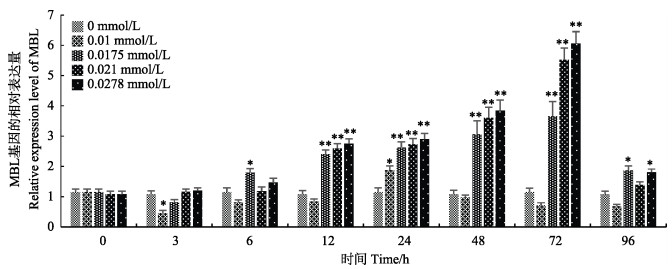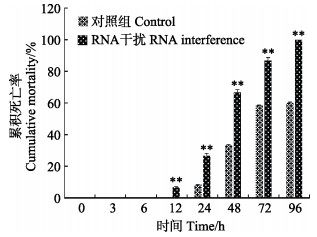2. 江苏省海洋生物产业技术协同创新中心 连云港 222005;
3. 江苏省农业种质资源保护与利用平台 南京 210014;
4. 江苏省海洋资源开发研究院(连云港) 连云港 222005
2. Co-Innovation Center of Jiangsu Marine Bio-Industry Technology, Huaihai Institute of Technology, Lianyungang 222005;
3. Jiangsu Provincial Infrastructure for Conservation and Utilization of Agricultural Germplasm, Nanjing 210014;
4. Marine Resource Development Institute of Jiangsu (Lianyungang), Lianyungang 222005
近年来,随着现代化工业的快速发展,大量工业废水排放导致重金属污染严重,威胁水产品的养殖与发展(黄福泉等, 2004; 王长友等, 2010; Vijayavel et al, 2009),在众多重金属污染中,镉是最严重也是毒性最强的重金属之一,为应优先关注的污染物之一(Hamza-Chaffai et al, 1995; Moreira et al, 2010)。水中的重金属主要通过鳃吸收、摄食、与水体的渗透交换作用等途径富集到生物体内(励建荣等, 2007; 赵红霞等, 2003; Pourang et al, 2010),进而对机体造成多方面的损伤。在生理水平上,镉会造成机体产生过量的活性氧,会直接损伤抗氧化系统(Pytharopoulou et al, 2008; Doyotte et al, 1997),也会对机体氨基酸和蛋白质如丝氨酸酶、丝氨酸蛋白酶抑制剂等的含量造成一定的影响(廖洁等, 2018; 黄婷, 2016; Dawood, 2012);在核基因组水平上,镉会损伤水生生物的DNA和DNA修复系统,致使机体出现畸形、突变等(毛跟军等, 2004);在细胞水平上,镉会通过影响蛋白质的结构及其生理功能,进而对甲壳类的肝胰腺等造成毒害作用(王兰等, 2004)。甘露糖集合凝集素(MBL)是先天免疫系统重要的成员,除了结合病原微生物表面的糖结构,发挥溶菌的作用(Gupta et al, 2008; Pradhan et al, 2010; Summerfield, 2003),还可以与丝氨酸蛋白酶结合激活补体途径的MBL途径,进而保护机体免受外界干扰(Walport, 2001; Presanis et al, 2003)。如上所述,Cd2+会造成机体丝氨酸蛋白酶的损伤,在生物机体受到Cd2+胁迫后,是否对MBL造成不同程度的影响?至今未见相关报道。
脊尾白虾(Exopalaemon carinicauda)是我国重要的经济虾类之一,以黄渤海产量最高(时冬晴等, 2007),而脊尾白虾养殖的近海海域受重金属污染的问题日益突出(李先超, 2001)。在前期的研究中,我们已克隆获得脊尾白虾甘露糖集合凝集素基因(已另文发表,GenBank登录号:MK105910),本研究通过对该基因在应答Cd2+胁迫下的表达特征分析,阐释该基因在重金属胁迫中的生物学功能。
1 材料与方法本实验首先选取健康虾和患病虾,验证MBL基因是否在患病虾中具有大量表达的特征,研究MBL基因在机体防御中是否发挥作用;利用重金属镉胁迫,研究MBL基因在机体受到镉离子胁迫后表达特征是否存在差异;利用RNA干扰技术,研究在机体在干扰后进一步受到镉离子胁迫后,MBL基因是否会参与脊尾白虾对镉的抵御。
1.1 实验材料实验所用健康成年脊尾白虾为实验室自繁而来,体长为(6.5±0.5) cm,体重为(2.5±0.5) g。实验前将脊尾白虾暂养在水温25℃、盐度25、pH为8.0的养殖缸内(50 cm×40 cm×30 cm),24 h不间断充氧,早晚投饵一次,投饵前对养殖缸进行清污。
1.2 实验样品的采集 1.2.1 脊尾白虾不同组织取材选取健康成年脊尾白虾(取自本实验室自繁养殖) 3尾,选取肌肉发白的患病脊尾白虾(来源菜市场) 3尾,实验前已对患病虾进行了病原检测,检测到微孢子虫的存在。分别选取其健康虾和患病虾的眼柄、胃、肝胰腺、心脏、鳃、肠、肌肉、卵巢共8个组织,用于RNA的提取。
1.2.2 镉离子胁迫实验取材通过文献得到Cd2+对脊尾白虾96 h的半致死质量浓度为3.650 mg/L,Cd2+对脊尾白虾的安全质量浓度为0.3650 mg/L(谢嘉等, 2017)。配制1 mol/L氯化镉(南京化学试剂有限公司生产)母液,配制4组不同浓度梯度的溶液,浓度分别为0.01、0.0175、0.021和0.0278 mmol/L,并设立对照组。实验过程在养殖箱(50 cm×40 cm×30 cm)内进行,每箱放50尾,整个养殖过程24 h不间断充气。
1.2.3 RNA干扰挑选健康活跃的成年脊尾白虾(对照组和实验组均为50尾,每次取3尾脊尾白虾),注射siRNA对MBL进行基因沉默,用于siRNA干扰的引物共4条(干扰部位为本实验室已获得的脊尾白虾MBL基因外显子的350~371 bp) (表 1),具体操作方法按照TR-102-T7 RNAi Transcripition Kit (Vazyme, 中国)的说明书进行。干扰组每克脊尾白虾注射4 μg siRNA,注射部位心脏表皮处,对照组每克脊尾白虾注射4 μg生理盐水。注射siRNA和生理盐水的脊尾白虾24 h后(按照RNA干扰试剂盒说明书,注射24 h是干扰效率最高的时间点),再进行镉胁迫(Cd2+浓度为0.021 mmol/L)。在4种胁迫浓度下,低浓度(0.01和0.0175 mmol/L)胁迫下,毒性较小,MBL表达量较少;高浓度(0.0278 mmol/L)胁迫下,脊尾白虾死亡太快,而只有0.021 mmol/L浓度下,脊尾白虾死亡率适中,实验可持续时间久,又可检测到MBL较高的表达量,胁迫养殖方法参照1.2.2。
|
|
表 1 脊尾白虾siRNA干扰引物和荧光定量PCR引物的序列 Tab.1 Primer sequence of Exopalaemon carinicauda siRNA interference and Q-PCR |
镉胁迫实验共设置8个取样点,分别在处理后0、3、6、12、24、48、72和96 h取样,RNAi干扰实验共设置8个取样点,分别为干扰后0、3、6、12、24、48、72和96 h取样,每个浓度均取3尾脊尾白虾,将脊尾白虾的肝胰腺经液氮冷冻、研磨后用RNA抽提试剂盒(上海生工生物工程有限公司)提取RNA。
1.4 脊尾白虾MBL基因组织特异性表达根据本实验室已获得的脊尾白虾MBL基因序列,设计荧光定量引物,分别命名为EC-MBL-Lectin- QR-F(正向扩增引物)和EC-MBL-Lectin-QR-R(反向扩增引物)(表 1),以18S rRNA为内参基因(薛蓓等, 2017)。实时荧光定量PCR反应使用SYBR Premix Ex TaqⅡ试剂盒(大连宝生物),PCR反应体系为20 μl:2×SYBR Premix Ex TaqTM Ⅱ 10.0 μl,ddH2O 4.0 μl,cDNA 4.0 μl,EC-MBL-Lectin- QR-F1 0.8 μl,EC-MBL- Lectin-QR-R1 0.8 μl,ROX Reference Dye 0.4 μl。
PCR反应程序:95℃ 30 s;95℃ 5 s,60℃ 31 s,40个循环;95℃ 15 s,60℃ 60 s,95℃ 15 s (熔解曲线程序)。
1.5 数据统计与分析每天记录各组实验中脊尾白虾的死亡个体数,计算累积死亡率,公式如下:
| $S(\%)=\left[D t_{1}+D t_{2}+\cdots \cdots+D t_{i}\right] / N \times 100 $ |
S为累积死亡率,D为脊尾白虾死亡个体数数,ti为记录天数,N为每个实验组中脊尾白虾的总数目。
采用SPSS 18.0和Excel软件对实验数据进行统计分析,并采用单因素方差分析(One-way ANOVA)进行差异显著性分析,在显著性结果的基础上应用Tukey法进行多重比较(P < 0.05为差异显著,P < 0.01为极显著差异)。
2 结果与分析 2.1 脊尾白虾MBL基因的组织表达分析利用荧光定量来研究MBL基因在脊尾白虾不同组织中的表达特征,检测结果如图 1所示。MBL基因在肝胰腺中表达量最高,且与其他组织存在显著性差异(P < 0.05);在其他组织(心脏、卵巢、胃、鳃、眼柄、肠和肌肉)中几乎不表达。

|
图 1 脊尾白虾MBL在健康虾和患病虾的不同组织的表达特征分析
Fig.1 Analysis of expression characteristics of MBL in different tissues of healthy shrimp and diseased shrimp
E:眼柄; S:胃; He:肝胰腺; H:心脏; G:鳃; I:肠; M:肌肉; O:卵巢 *表示与对照组差异显著(P < 0.05),**表示与对照组差异极显著(P < 0.01)。下同 E: Eye stalk; S: Stomach; He: Liver and pancreas; H: Heart; G: Sputum; I: Intestine; M: Muscle; and O: Gonad * indicates a significant difference from the control group (P < 0.05), and ** indicates a significant difference from the control group (P < 0.01). The same as below |
肌肉发白的脊尾白虾(购自菜市场)利用荧光定量对其MBL基因不同组织的表达特征进行分析,检测结果如图 1所示,其中,在肝胰腺中表达量最高,且与其他组织存在显著差异(P < 0.05),其次是心脏。患病组和健康组比对发现(图 1),MBL基因在患病虾的肝胰腺和心脏中表达量较健康虾显著增加。
2.2 镉离子胁迫后不同浓度和不同时间点的脊尾白虾MBL基因表达分析总体而言,与对照组相比,各胁迫组中脊尾白虾的MBL基因在肝胰腺中的相对表达量随时间的延长而增加,但脊尾白虾MBL基因在肝胰腺中的相对表达量在不同浓度镉离子随时间的变化出现明显的差异(图 2)。镉离子浓度为0.01 mmol/L时,脊尾白虾MBL基因在肝胰腺中的相对表达量基本呈现下降的趋势,但在6 h和24 h时有上升趋势,与对照组差异显著(P < 0.05);镉离子浓度分别为0.0175、0.021和0.0278 mmol/L时,在胁迫初期,脊尾白虾MBL基因在肝胰腺中的相对表达量基本没有变化,在12 h后呈上升趋势,3种浓度均在胁迫72 h时达到高峰,并与对照组差异显著(P < 0.01),72 h之后开始下降。

|
图 2 不同镉离子浓度胁迫下脊尾白虾MBL表达量 Fig.2 Expression of MBL in white shrimp with different cadmium concentrations |
脊尾白虾MBL基因的相对表达量在RNA干扰后的变化如图 3所示。重金属镉胁迫后,干扰组和对照组脊尾白虾MBL基因在肝胰腺中的相对表达量均呈现上升趋势,但干扰组和对照组相比,干扰组脊尾白虾MBL基因在肝胰腺中的相对表达量均低于对照组。在6、12、24、48、72和96 h时,RNA干扰组和对照组的脊尾白虾MBL基因在肝胰腺中的相对表达量出现显著性差异(P < 0.01)。

|
图 3 RNA干扰后脊尾白虾MBL表达量随时间的变化 Fig.3 Changes of MBL expression in E. carinicauda after RNA interference |
脊尾白虾累积死亡率在RNA干扰前后存在显著差异,如图 4所示,镉胁迫后的0、3、6 h 3个时间段,干扰组和对照组脊尾白虾的累积死亡率基本相同,但在12、24、48、72和96 h后,干扰组的累积死亡率显著高于对照组。

|
图 4 RNA干扰后脊尾白虾累积死亡率随时间的变化 Fig.4 Changes in cumulative mortality of E. carinicauda after RNA interference |
早期研究发现,甲壳类动物凝集素在血细胞或肝胰腺中的表达量最高,因此,这些组织被认为是甲壳类动物防御系统中重要的器官(Söderhäll et al, 1998; Gross et al, 2001),本研究在脊尾白虾MBL的组织特异性表达分析中发现,脊尾白虾MBL在肝胰腺中表达最多,并与其他组织存在显著性差异,因此,作者认为肝胰腺是脊尾白虾MBL主要的效应组织。与肌肉发白的患病虾进行比对时发现,患病虾MBL在肝胰腺的表达量较健康虾显著增加,这可能说明MBL在肝胰腺发挥着相应的应激作用。研究表明,虾蟹对重金属镉的积累具有明显的组织特异性,主要富集在鳃、甲壳和肝胰腺(Silvestre et al, 2004、2005),而肝胰腺又是脊尾白虾MBL的主要效应组织。
为了探讨MBL在重金属镉离子胁迫下的表达特征,本研究利用4种重金属镉离子浓度进行胁迫,发现较高浓度的镉离子诱导MBL在肝胰腺中的表达量呈先上升后下降的趋势,镉离子浓度较低时,MBL的表达量整体呈下降趋势。在先前的研究中发现,镉离子胁迫后水生生物机体内抗氧化酶活力和丙二醛(许星鸿等, 214)、黄嘌呤氧化酶(刘伟成等, 2006)、热休克蛋白(生安志等, 2016)出现先上升后下降的趋势,这与本研究中MBL在脊尾白虾受到镉离子胁迫后出现的结果相一致。因此,脊尾白虾MBL对镉离子具有一定的应激作用,但Cd2+胁迫后脊尾白虾MBL发挥作用存在着时间和剂量问题,高剂量的Cd2+会诱导脊尾白虾MBL发挥应激作用。
为进一步验证脊尾白虾MBL基因是否与镉离子胁迫有直接的关系,本研究进一步利用RNA干扰技术对脊尾白虾MBL基因进行干扰研究。荧光定量结果显示,干扰组脊尾白虾MBL基因在肝胰腺中的相对表达量均低于对照组,说明干扰是成功的。在此基础上,进一步对MBL表达受到干扰的脊尾白虾进行镉离子胁迫,结果发现,干扰组的死亡率也显著高于对照组。由上述实验结果推测,这可能由脊尾白虾对镉离子抵御能力降低导致。以往的研究已经证实,金属硫蛋白(MT)具有重金属解毒的作用,在缺失MT基因的酵母基因转入MT基因,酵母便对重金属铜产生了抗性(Thiele et al, 1986),过量表达MT基因的转基因小鼠和苍蝇(Musca domestica)提高了对重金属镉的耐受性(Liu et al, 1995; Tang et al, 2011),因此,我们认为当脊尾白虾受重金属镉离子胁迫后,脊尾白虾MBL发挥了一定的抵御作用,但其应答机制尚需进一步研究。
Dawood M. Physiological mechanism of hydrogen sulfide- mediated alleviation of aluminum, cadmium and salinity stresses and effects of sulfur nutrition on growth and grain quality of barley. Doctoral Dissertation of Zhejiang University, 2012 [[Muhammad Dawood大宇).硫化氢缓解铝、镉和盐胁迫及硫营养影响大麦生长与品质的生理机制.浙江大学博士研究生学位论文, 2012]
|
Doyotte A, Cossu C, Marie-Cécile J, et al. Antioxidant enzymes, glutathione and lipid peroxidation as relevant biomarkers of experimental or field exposure in the gills and the digestive gland of the freshwater bivalve Unio tumidus. Aquatic Toxicology, 1997, 39(2): 93-110 DOI:10.1016/S0166-445X(97)00024-6 |
Gross PS, Bartlett TC, Browdy CL, et al. Immune gene discovery by expressed sequence tag analysis of hemocytes and hepatopancreas in the Pacific white shrimp, Litopenaeus vannamei, and the Atlantic white shrimp, L. setiferus. Developmental and Comparative Immunology, 2001, 25(7): 565-577 DOI:10.1016/S0145-305X(01)00018-0 |
Gupta K, Gupta RK, Hajela K. Disease associations of mannose-binding lectin & potential of replacement therapy. Indian Journal of Medical Research, 2008, 127(5): 431-440 |
Hamza-Chaffai A, Cosson RP, Amiard-Triquet C, et al. Physico- chemical forms of storage of metals (Cd, Cu and Zn) and metallothionein-like proteins in gills and liver of marine fish from the Tunisian coast: Ecotoxicological consequences. Comparative Biochemistry and Physiology Part C: Pharmacology, Toxicology and Endocrinology, 1995, 111(2): 349-331 |
Huang FY, Li MY, Zhu JQ, et al. Influence of cadmium on the expression of isozymes in blood cells of Boleophthalmus pectinirostris in the situation of acute toxicosis. Journal of Shanghai Fisheries University, 2004, 13(4): 289-292 [黄福勇, 李明云, 竺俊全, 等. 急性镉中毒对大弹涂鱼血细胞同工酶表达的影响. 上海海洋大学学报, 2004, 13(4): 289-292 DOI:10.3969/j.issn.1004-7271.2004.04.001] |
Huang T. Physiology and transcriptome of mustard responsive to cadmium stress. Masterxs Thesis of Hunan University of Science and Technology, 2016 [黄婷.芥菜响应镉胁迫的生理和转录组研究.湖南科技大学硕士研究生学位论文, 2016]
|
Li JR, Li XP, Wang L, et al. Advances in uptake, transportation and bioaccumulation of heavy metal ions in bivalves. Fisheries Science, 2007, 26(1): 51-55 [励建荣, 李学鹏, 王丽, 等. 贝类对重金属的吸收转运与累积规律研究进展. 水产科学, 2007, 26(1): 51-55 DOI:10.3969/j.issn.1003-1111.2007.01.012] |
Li XC. The study on the current ecological environment situation and its developmental feather in off-shore area of Shandong Province (focus on Yellow Sea). Doctoral Dissertation of Ocean University of China, 2011 [李先超.山东近岸海域(黄海部分)生态环境现状及演变特征研究.中国海洋大学博士研究生学位论文, 2011]
|
Liao J, He J, Mo LX, et al. Effects of cadmium stress on cadmium and free amino acids content in sugarcane. Southwest China Journal of Agricultural Sciences, 2018, 2(13): 296-301 [廖洁, 何洁, 莫磊兴, 等. 镉胁迫对甘蔗体内镉及游离氨基酸含量的影响. 西南农业学报, 2018, 2(13): 296-301] |
Liu WC, Li MY, Huang FY, et al. Cadmium-induced changes to the activity of xanthine oxidase in liver of Boleophthalmus pectinirostris. Marine Fisheries Research, 2006, 27(3): 21-25 [刘伟成, 李明云, 黄福勇, 等. 重金属镉胁迫对大弹涂鱼肝脏黄嘌呤氧化酶活性的影响. 海洋水产研究, 2006, 27(3): 21-25] |
Liu YP, Liu J, Iszard MB, et al. Transgenic mice that overexpress metallothionein-I are protected from cadmium lethality and hepatotoxicity. Toxicology and Applied Pharmacology, 1995, 135(2): 222-228 DOI:10.1006/taap.1995.1227 |
Mao GJ, Xu MD, Huang JW. Toxic and harmful substances in the environment and analysis and detection. Beijing: Chemical Industry Press, 2004: 158-162 [毛跟军, 许牡丹, 黄建文. 环境中有毒有害物质与分析检测. 北京: 化学工业出版社, 2004: 158-162]
|
Moreira CSA, Ferracciú LR. Adsorption of Cd, Cu, Ni and Zn in tropical soils under competitive and non-competitive systems. Scientia Agricola, 2010, 67(3): 301-307 DOI:10.1590/S0103-90162010000300008 |
Pourang N, Richardson CA, Mortazavi MS. Heavy metal concentrations in the soft tissues of swan mussel (Anodonta cygnea) and surficial sediments from Anzali wetland, Iran. Environmental Monitoring and Assessment, 2010, 163(1-4): 195-213 DOI:10.1007/s10661-009-0827-7 |
Pradhan V, Surve P, Ghosh K. Mannose binding lectin (MBL) in autoimmunity and its role in systemic lupus erythematosus (SLE). Journal of the Association of Physicians of India, 2010, 58(11): 688-690 |
Presanis JS, Kojima M, Sim RB. Biochemistry and genetics of mannan-binding lectin (MBL). Biochemical Society Transactions, 2003, 31(4): 748-752 DOI:10.1042/bst0310748 |
Pytharopoulou S, Sazakli E, Grintzalis K, et al. Translational responses of Mytilus galloprovincialis to environmental pollution: Integrating the responses to oxidative stress and other biomarker responses into a general stress index. Aquatic Toxicology, 2008, 89(1): 18-27 |
Sheng AZ, Ju HM, Li GY, et al. Expression patterns of Hsp90 of Paralichthys olivaceus in response to temperature treatment and Vibrio anguillarum infection. Progress in Fishery Sciences, 2016, 37(5): 1-8 [生安志, 鞠辉明, 李贵阳, 等. 牙鲆(Paralichthys olivaceus) Hsp90 mRNA在温度刺激和鳗弧菌感染下的表达特征. 渔业科学进展, 2016, 37(5): 1-8] |
Shi DQ, Ye JS. Effects of temperature and nutrients on the growth of somatic cells in Porphyra yezoensis. Agricultural Economics and Management, 2007(5): 40-42 [时冬晴, 叶建生. 脊尾白虾的生物学特性及健康养殖技术. 农业经济与管理, 2007(5): 40-42 DOI:10.3969/j.issn.1674-9189.2007.05.010] |
Silvestre F, Trausch G, Péqueux A, et al. Uptake of cadmium through isolated perfused gills of the Chinese mitten crab, Eriocheir sinensis. Comparative Biochemistry and Physiology Part A: Molecular and Integrative Physiology, 2004, 137(1): 189-196 |
Silvestre F, Trausch G, Devos P. Hyper-osmoregulatory capacity of the Chinese mitten crab (Eriocheir sinensis) exposed to cadmium; acclimation during chronic exposure. Comparative Biochemistry and Physiology Part C: Toxicology and Pharmacology, 2005, 140(1): 29-37 DOI:10.1016/j.cca.2004.12.007 |
Söderhäll K, Cerenius L. Role of the prophenoloxidase- activating system in invertebrate immunity. Current Opinion in Immunology, 1998, 10(1): 23-28 DOI:10.1016/S0952-7915(98)80026-5 |
Summerfield JA. Clinical potential of mannose-binding lectin- replacement therapy. Biochemical Society Transactions, 2003, 31(4): 770-773 DOI:10.1042/bst0310770 |
Tang T, Huang DW, Zhang D, et al. Identification of two metallothionein genes and their roles in stress responses of Musca domestica toward hyperthermy and cadmium tolerance. Comparative Biochemistry and Physiology Part B: Biochemistry and Molecular Biology, 2011, 160(2-3): 81-88 DOI:10.1016/j.cbpb.2011.06.008 |
Thiele D, Walling M, Hamer D. Mammalian metallothionein is functional in yeast. Science, 1986, 231(4740): 854-856 DOI:10.1126/science.3080806 |
Vijayavel K, Gopalakrishnan S, Thiagarajan R, et al. Immunotoxic effects of nickel in the mud crab Scylla serrata. Fish and Shellfish Immunology, 2009, 26(1): 133-139 |
Walport MJ. Complement first of two parts. New England Journal of Medicine, 2001, 344(14): 1058-1066 DOI:10.1056/NEJM200104053441406 |
Wang CY, Wang XL, Li KQ, et al. The estimation of copper, lead, zinc and cadmium fluxes into the sea area of the East China Sea interferenced by terrigenous matter and their environmental capacities. Acta Oceanologica Sinica, 2010, 32(4): 62-76 [王长友, 王修林, 李克强, 等. 东海陆扰海域铜、铅、锌、镉重金属排海通量及海洋环境容量估算. 海洋学报, 2010, 32(4): 62-76] |
Wang L, Wang DX, Wang Q, et al. Effect of cadmium on ultrastructure of hepatopancreas cell of freshwater carb (Sinopotamon yangtsekiense). Acta Anatomica Sinica, 2003, 34(5): 522-526 [王兰, 王定星, 王茜, 等. 镉对长江华溪蟹肝胰腺细胞超微结构的影响. 解剖学报, 2003, 34(5): 522-526 DOI:10.3321/j.issn:0529-1356.2003.05.018] |
Xie J, Teng J, Liu YL, et al. Single and joint acute toxic effects of cadmium and lead on Palaemon carincauda. Marine Sciences, 2017(5): 27-33 [谢嘉, 滕佳, 刘永亮, 等. Cd2+和Pb2+单一与复合污染对脊尾白虾的急性毒性效应研究. 海洋科学, 2017(5): 27-33] |
Xu XH, Yan BL, Xu JT, et al. Effects of cadmium stress on activities of antioxidant enzymes, malonaldehyde content and cadmium accumulation in Asian swimming crab Charybdis japonica. Fisheries Science, 2014, 33(9): 551-555 [许星鸿, 阎斌伦, 徐加涛, 等. 重金属镉胁迫对日本蟳抗氧化酶活力、丙二醛含量及组织蓄积的影响. 水产科学, 2014, 33(9): 551-555 DOI:10.3969/j.issn.1003-1111.2014.09.003] |
Xue B, Zhang P, Li ZH, et al. Cloning, expression and stability analysis of the reference gene glyceraldehyde-3-phosphate dehydrogenase (GAPDH) in Exopalaemon carinicauda. Journal of Fishery Sciences of China, 2017, 24(5): 1003-1012 [薛蓓, 张培, 李志辉, 等. 脊尾白虾GAPDH基因的克隆及其内参基因稳定性分析. 中国水产科学, 2017, 24(5): 1003-1012] |
Zhao HX, Zhou M, Zhan Y, et al. Research progress on toxicity of heavy metals to aquatic animals. Jiangxi Feed, 2003, 28(2): 13-18 [赵红霞, 周萌, 詹勇, 等. 重金属对水生动物毒性的研究进展. 江西饲料, 2003, 28(2): 13-18 DOI:10.3969/j.issn.1008-6137.2003.02.006] |



